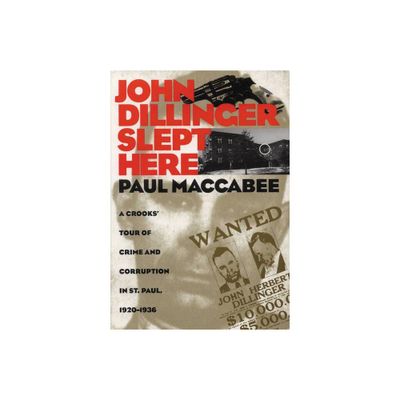Home
Leading the Dillinger Gang: The Lives and Legacies of John Dillinger and Baby Face Nelson
Loading Inventory...
Barnes and Noble
Leading the Dillinger Gang: The Lives and Legacies of John Dillinger and Baby Face Nelson
Current price: $11.14


Barnes and Noble
Leading the Dillinger Gang: The Lives and Legacies of John Dillinger and Baby Face Nelson
Current price: $11.14
Loading Inventory...
Size: OS
*Product Information may vary - to confirm product availability, pricing, and additional information please contact Barnes and Noble
*Comprehensively covers the two outlaws' most notorious shootouts and robberies, their relationship, and their deaths.
*Includes pictures of Dillinger, Baby Face Nelson and important people and places in their lives.
*Includes a Bibliography for further reading. "I will be the meanest bastard you ever saw when I get out of here." - John Dillinger
"He had a baby face. He was good looking, hardly more than a boy, had dark hair and was wearing a gray topcoat and a brown felt hat, turned down brim." -The wife of Chicago Mayor Big Bill Thompson describing the man who attacked her and stole her jewelry in October 1930.
America has always preferred heroes who weren't clean cut, an informal ode to the rugged individualism and pioneering spirit that defined the nation in previous centuries. The early 19th century saw the glorification of frontier folk heroes like Davy Crockett and Daniel Boone. After the Civil War, the outlaws of the West were more popular than the marshals, with Jesse James and Billy the Kid finding their way into dime novels. And at the height of the Great Depression in the 1930s, there were the "public enemies", common criminals and cold blooded murderers elevated to the level of folk heroes by a public frustrated with their own inability to make a living honestly.
Two months after Franklin D. Roosevelt's inauguration in 1933, a petty thief who had spent almost a decade behind bars for attempted theft and aggravated assault was released from jail. By the end of the year, that man, John Dillinger, would be America's most famous outlaw: Public Enemy Number One. From the time of his first documented heist in early July 1933, until his dramatic death in late July of the following year, he would capture the nation's attention and imagination as had no other outlaw since Jesse James. America saw in Dillinger what it wanted to see, and even his death seemed scripted for Hollywood.
The man who became Public Enemy Number One after the deaths of John Dillinger and Pretty Boy Floyd was Lester Joseph Gillis, whose alias "George Nelson" eventually gave way to the nickname "Baby Face Nelson". Despite the almost playfully innocent nickname, and the fact that he was not as notorious as two of his partners in crime, Dillinger and Floyd, Baby Face Nelson was the worst of them all.
In an era where the outlaws were glorified as Robin Hood types, Baby Face was a merciless outlier who pulled triggers almost as fast as he lost his temper. By the time fate caught up with Baby Face Nelson in November 1934 at the "Battle of Barrington", a shootout that left his body riddled with nearly 20 bullet holes, he was believed to have been responsible for the deaths of more FBI agents than anybody else in American history. It was a distinction he would have appreciated; during one bank robbery, Baby Face Nelson gleefully screamed "I got one!" after shooting police officer Hale Keith several times.
Due to his association with Dillinger and his own crime spree, Baby Face Nelson became a fixture of pop culture and was the main character in a few Hollywood films two decades after his death. Though he is not remembered as colorfully as Dillinger or Bonnie and Clyde, he is often remembered paradoxically as being a devoted family man who even had his wife and children on the run with him.
Leading the Dillinger Gang looks at the lives and crimes of the two outlaws, including their time together running the Dillinger gang, and it also analyzes their legacies. Along with pictures of the outlaws and important people, places, and events in their lives, you will learn about Dillinger and Baby Face like never before.
*Includes pictures of Dillinger, Baby Face Nelson and important people and places in their lives.
*Includes a Bibliography for further reading. "I will be the meanest bastard you ever saw when I get out of here." - John Dillinger
"He had a baby face. He was good looking, hardly more than a boy, had dark hair and was wearing a gray topcoat and a brown felt hat, turned down brim." -The wife of Chicago Mayor Big Bill Thompson describing the man who attacked her and stole her jewelry in October 1930.
America has always preferred heroes who weren't clean cut, an informal ode to the rugged individualism and pioneering spirit that defined the nation in previous centuries. The early 19th century saw the glorification of frontier folk heroes like Davy Crockett and Daniel Boone. After the Civil War, the outlaws of the West were more popular than the marshals, with Jesse James and Billy the Kid finding their way into dime novels. And at the height of the Great Depression in the 1930s, there were the "public enemies", common criminals and cold blooded murderers elevated to the level of folk heroes by a public frustrated with their own inability to make a living honestly.
Two months after Franklin D. Roosevelt's inauguration in 1933, a petty thief who had spent almost a decade behind bars for attempted theft and aggravated assault was released from jail. By the end of the year, that man, John Dillinger, would be America's most famous outlaw: Public Enemy Number One. From the time of his first documented heist in early July 1933, until his dramatic death in late July of the following year, he would capture the nation's attention and imagination as had no other outlaw since Jesse James. America saw in Dillinger what it wanted to see, and even his death seemed scripted for Hollywood.
The man who became Public Enemy Number One after the deaths of John Dillinger and Pretty Boy Floyd was Lester Joseph Gillis, whose alias "George Nelson" eventually gave way to the nickname "Baby Face Nelson". Despite the almost playfully innocent nickname, and the fact that he was not as notorious as two of his partners in crime, Dillinger and Floyd, Baby Face Nelson was the worst of them all.
In an era where the outlaws were glorified as Robin Hood types, Baby Face was a merciless outlier who pulled triggers almost as fast as he lost his temper. By the time fate caught up with Baby Face Nelson in November 1934 at the "Battle of Barrington", a shootout that left his body riddled with nearly 20 bullet holes, he was believed to have been responsible for the deaths of more FBI agents than anybody else in American history. It was a distinction he would have appreciated; during one bank robbery, Baby Face Nelson gleefully screamed "I got one!" after shooting police officer Hale Keith several times.
Due to his association with Dillinger and his own crime spree, Baby Face Nelson became a fixture of pop culture and was the main character in a few Hollywood films two decades after his death. Though he is not remembered as colorfully as Dillinger or Bonnie and Clyde, he is often remembered paradoxically as being a devoted family man who even had his wife and children on the run with him.
Leading the Dillinger Gang looks at the lives and crimes of the two outlaws, including their time together running the Dillinger gang, and it also analyzes their legacies. Along with pictures of the outlaws and important people, places, and events in their lives, you will learn about Dillinger and Baby Face like never before.


















